|

| |
I Always Spize A
Mule Banks, by Bill Norman
(second article in this series)
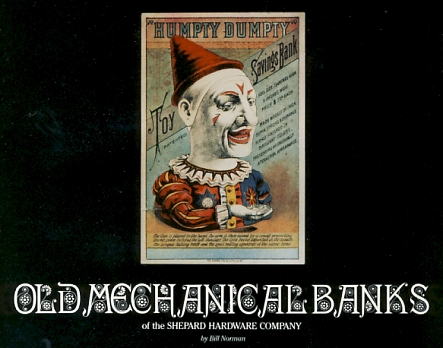
COLLECTORS’ SHOWCASE, Volume 1, Number 4
March/April 1982, pages 27 through 34
OLD MECHANICAL BANKS
of the SHEPARD HARDWARE
COMPANY
by Bill Norman
Collectors have sought after old mechanical banks for over 50 years.
The nostalgic past of our American heritage is reflected in the
interesting themes and animated action of these toy savings banks, making
them educational and timelessly wonderful objects to behold.
Mechanical banks began to appear shortly after the end of the
American Civil War and the American public was eager to purchase them.
This market was generated as a natural outgrowth of the events that
occurred during the war years (1862-1865). There was a severe coin
shortage during this time, due in part because the public was saving
(hoarding) them. In fact, the situation got so bad that postage stamps
were often used to make change. Both the Union and Confederate governments
began issuing paper notes to supplement their coinage and help relieve
this problem. But, as you can well imagine, the public didn’t like paper
money. This currency wasn’t trusted. It could become as worthless as last
week’s newspaper, especially of the side that would lose the war. However,
coins would always retain some metallic value.
Hence, mechanical banks were a product of the times and their
popularity remained strong well into the 20th century. Not only
were they fun toys, but parents could effectively use them to teach their
children the practical aspects of being thrifty. What a great idea!
One outstanding and important producer of old mechanical banks was
the Shepard Hardware Company of Buffalo, New York, and it is the old
Shepard operation and their banks that this article is all about.
The Old Shepard Operation
Relatively little is known about the Shepard Hardware Company. They
were obviously in the business of designing and selling hardware items, as
were some of the other producers of cast iron mechanical banks. Much can
be learned about their hardware business, by studying the many hardware
related design patents they held. There are no remains of the company. So,
visiting the original site in Buffalo, New York, will generate little
information.
Walter J. and Charles G. Shepard were apparently the main principals
in the business, which can be surmised by the fact that all Shepard bank
design patents were owned or assigned to them. I doubt if anyone knows
whether they were brothers, father and son, cousins, or what. However,
Charles was an inventor. He and Peter Adams co-patented the designs for at
least 12 of Shepard’s 15 mechanical banks and, in each case, Mr. Adams
assigned his interest over to Walter J. Shepard of the same company.
I would speculate that Walter was probably more business oriented
than Charles and probably tended to administrative matters, while Charles
worked on the bank designs with Adams.
In any event, Shepard entered into the mechanical bank field in about
1882 and available information indicates they sold out their line of toy
banks in 1892. The impact Shepard had on the mechanical bank market was
astounding when you consider the fact they were able to design, patent,
produce, and effectively distribute 15 high quality banks within a time
span of only about 10 years.
It is a generally accepted fact that Shepard originated the full
color “trading card” method of advertising mechanical banks. These cards
are about 2-1/2" X 5-1/2" in size and were printed on thick paper stock.
They were used by Shepard bank dealers to promote the sale of the banks to
their customers. Each card shows the retail price at $1.00 each for a
bank. Introductory dealer cards also listed the wholesale bank price,
which was $8.50 per dozen. This translates to about 70¢ each, for a 30%
wholesale discount.
Old mechanical bank trading cards have become quite collectable and
are difficult to find. Examples of Shepard cards are illustrated herein.
Wherever possible, the bank operating instructions are directly quoted
from an old trading card. It’s interesting to note that Shepard paid
little attention to grammatical correctness. I think you will find
Shepard’s wording and lack of punctuation nostalgically amusing.
Characteristics of Shepard’s Banks
Several identifying features are common to Shepard mechanical banks.
In the first place, their artistic paint jobs were unsurpassed for
attention to minute detail. It’s amazing that a high production cast iron
toy could contain the incredible craftsmanship that Shepard got from their
painters. However, on the negative side, they used no primer coating to
prepare the metal for painting, which accounts for why most Shepard banks
are found in such poor paint condition. It simply flaked off the bank.
But, if you are fortunate enough to have a fine condition Shepard
mechanical, you will appreciate the quality of its fine artistic paint
job.
Secondly, each Shepard bank has its name embossed on one of the
casting pieces. The name is generally in large bold letters located on the
front panel of the bank. Some mechanicals, of the other manufacturers, had
no name on them, with the result that many banks are known by names other
than the ones originally given them. Shepard mechanicals do not fall into
this category.
And, in the third place, each Shepard mechanical is very heavy for
its physical size. It’s almost as if cast iron was free and had no bearing
on the production cost of the items. An interesting footnote is the first
8 Shepard banks can be categorized in groups of two. It’s almost like they
were designed in pairs.
The 15 Shepard Banks
1. JOLLY NIGGER BANK
Patented March 14, 1882, #12,814.
“The Coin is placed in the palm of the hand when the Arm is raised
automatically by a small projecting thumb-piece behind the left shoulder
depositing the coin in the mouth: the tongue falling back and the eyes
rolling upwards at the same time.”
Today, some people might find this characterization offensive.
However, the black race was thought of as a happy-go-lucky bunch, which is
reflected by the smile on his face. This bank was by far the most popular
mechanical theme of all time. It was produced for 10 years by Shepard,
which was followed with another 40 years of production by the J. & E.
Stevens Company. In addition, many similar banks were made in England, and
countless reproductions make it difficult to discern the modern banks from
the “old” (Pre-1935) items. (The base length is 5-13/16".)
2. HUMPTY DUMPTY BANK
Patented June 17, 1884, # 15,085.
“The Coin is placed in the hand, the arm is then raised by a small
projecting thumb piece behind the left shoulder, the Coin being deposited
in the mouth, the tongue falling back and the eyes rolling upwards at the
same time.” (Same action, different wording, as the JOLLY NIGGER BANK.)
Humpty Dumpty was a famous and beloved clown of the era, who was
portrayed by George L. Fox. In 1975 Mr. Sy Schreckinger (a mechanical bank
collector) turned up an old 1878 vintage poster of Mr. Fox, which almost
looks as if it could have been used to inspire the bank design. (The base
length is 5".)
3. PUNCH AND JUDY BANK
Patented July 22, 1884, # 15,155.
“Judy receives the Coin in the plate. The thumb-piece at the side is
pressed upon, and Punch rushes forward brandishing a club when Judy turns
quickly and deposits the Coin in the bank.”
The famous puppet show is fast becoming lost to our young “Sesame
Street” generation. However, the term “puppet show” and “Punch & Judy”
were almost synonymous for several hundred years.
There are two common lettering variations; large letters, and small
letters. The one illustrated is the small letter variety.
4. PICTURE GALLERY BANK
Circa 1885. This is the
only Shepard bank of record that was not covered by a U.S. design patent.
Give the cashier a coin, pull the lever, and he will turn and place
your deposit into the bank. Push on a second lever and the wheel will
rotate one notch; displaying a letter, number, and a word/picture.
A child could learn his alphabet, numbers, and how to spell words on
the PICTURE GALLERY BANK. A most practical and novel idea.
The base plate of the PICTURE GALLERY identifies it as an “Excelsior
Series” item. It was Shepard’s first bank to utilize a locking coin trap,
and this rectangular locking design became the standard “trap” for almost
all succeeding Shepard bank designs. It’s easy to see why they were proud
of this item; it was “Excelsior” indeed!
The PICTURE GALLERY BANK is difficult to find, especially in good
paint condition.
5. TRICK PONY BANK
Patented June 2, 1885 by Juleus Mueller of Wilmington, North
Carolina (# 16,121). The patent rights were assigned to Charles and Walter
Shepard.
Place a coin in the pony’s mouth, pull the lever, he bows his head
and the bottom of the feeding trough opens to receive the deposit.
The TRICK PONY was Shepard’s first animal theme bank and is their
only mechanical of record patented by someone other than Charles Shepard
and/or Peter Adams. It also used the rectangular locking coin trap. (The
base length is 7-1/6".)
6. SPEAKING DOG BANK
Patented October 20, 1885, # 328,723.
“The coin is placed in a plate held by the girl. The thumb piece is
pressed upon, when the girl’s arm moves quickly and deposits the coin
through a trap door in the bench that opens to receive it. At the same
time the dog opens and closes his mouth as if ‘speaking’ and also wags his
tail.”
The SPEAKING DOG BANK was a very popular item, in part, because it
appealed to both boys and to girls. It was one of the three Shepard banks
whose production was continued by the Stevens Company after 1892. The
rectangular locking trap was also used on this item.
7. UNCLE SAM BANK
Patented June 8, 1886, # 16,728.
“A very comical appearance is given to the face, the lower jaw being
balanced on pivots and easily kept in motion.
The coin is placed in the hand, and the small knob on top of box
pressed upon, which lowers the arm and opens the satchel to receive the
deposit, the lower jaw in the face moving at the same time.”
Much could be written about the historical significance of Uncle Sam.
But, I think it’s sufficient to say that his initials (U.S.) stand for the
United States, and every U.S. citizen is well aware of their famous uncle.
Although the original bank was probably made for not more than 6
years, its popularity had caused many reproductions to follow. In fact,
Uncle Sam reproductions are still being made at the time of this writing.
One unique part of this design is the rectangular locking coin trap
located on the back panel of the bank, as opposed to being on the bottom.
Therefore, the trap was painted to match the red color of the bank and,
while many collectors are not too particular whether a bank contains its
respective coin trap, the UNCLE SAM BANK is generally devalued if its trap
is either missing or recast. (The base length is 4-15/16".)
8. STUMP SPEAKER BANK
Patented November 16, 1886, # 352,786.
It’s interesting to note that the bank has a different patent date
(June 8, 1886) stamped on its bottom plate. This is the date of the UNCLE
SAM patent. Both patent applications were filed on the same day and, for
some reason, the U.S. Patent Office delayed granting the STUMP SPEAKER
patent for five months. I think it is safe to say that Shepard did not
want to delay STUMP SPEAKER production and chose to emboss the UNCLE SAM
date on both banks.
“A very comical appearance is given to the face, the lower jaw being
balanced on pivots and easily kept in motion.
The coin is placed in the hand, and the small knob on the top of the
box pressed upon, which lowers the arm and opens the satchel to receive
the deposit, the lower jaw in the face moving at the same time.” (The
instructions are identical to UNCLE SAM’s.)
This “Stump Speaker” appears to be a “Carpetbagger.” They were
unethical politicians who traveled around the South after the Civil War,
taking advantage of the turmoil in that part of the country. Their
belongings were carried in a carpet bag and, as you can see, money was
also quick to be put into the bag.
The STUMP SPEAKER BANK has an identical coin trap arrangement as the
UNCLE SAM BANK, and similar devaluation can result if the trap is either
missing or recast. (The base length is 4-15/16".)
9. MASON BANK
Patented February 2, 1887, # 17,108.
“The comical appearing Hod Carrier receives the Coin in Hod, and
throws it forward depositing it in the Bank. The Mason raises & lowers
trowel, also brick, while the Hod is moving forward and back.”
This beautiful bank was undoubtedly appealing to children and to many
adults. I would guess that most Masons would have been proud to display a
MASON BANK on their shelf. It was labeled as part of the “Excelsior
Series” and the bank also contained their standard rectangular locking
coin trap. (The base length is 7-3/8".)
10. TRICK DOG BANK
“PAT. JULY 31, 1888” is stamped on its base plate. However,
apparently no U.S. design patent was issued on the bank.
Place a coin in the little dog’s mouth, press the lever and he will
jump through the clown’s hoop and drop your deposit into the barrel.
The TRICK DOG is unique because it is the only bank sold by Shepard
that was later produced by someone other than the J. & E. Stevens Company.
Two later versions of this item were made by the Hubley Toy Company of
Lancaster, Pa.
The Shepard TRICK DOG BANK utilizes a 6-part base that is held
together by two slot-head screws. The side plates are painted red with
yellow trim and the bank shows off Shepard’s typical attention to artistic
detail. An original wooden box exists that contained a Shepard TRICK DOG.
It says, “one complete ‘TRICK DOG’ savings bank Excelsior Series ― S.H.
Company. 98¢.” (The original Shepard base plate is 8-11/16" in length.)
11. CIRCUS BANK
Patented September 9, 1888, # 19,618.
“Place a coin upon the bracket in front of the money receptacle. When
the crank is turned the pony goes around the ring and the clown deposits
the coin. The pony kicks up the wheels turn and the clowns arm moves up
and down making it a very amusing toy.”
The CIRCUS BANK is the rarest of all Shepard’s mechanicals. There are
probably two major reasons for this. In the first place, the
clown/pony/cart section was very fragile and could break off the bank.
Without these pieces, a CIRCUS BANK would be of little value and probably
ended up being discarded. Secondly, the CIRCUS BANK probably didn’t have a
high level of production, because it would have been expensive to make.
It’s large size (7" x 8-1/2"), heavy weight (5 pounds), and large number
of casting pieces (about 24), could make for slim profits, when you
consider that CIRCUS banks sold for the same price as the other Shepard
mechanicals.
Like the UNCLE SAM and STUMP SPEAKER banks, the CIRCUS BANK used a
locking coin trap that was located on the rear panel rather than on the
bottom of the bank. However, this trap is of an irregular size and shape,
making it very rare as a spare bank part.
12. SANTA CLAUS
Patented October 15, 1889, # 19,356.
Give a coin to Santa, press the lever and he puts your deposit into
the chimney.
The SANTA CLAUS bank was a real departure from the other Shepard
designs. Its small size was unique and its coin trap is long and narrow,
requiring a screw driver to remove. In fact, the trap is so narrow that it
is very difficult to remove coins from the bank, and it was probably more
expedient to take the chimney apart than to fuss with the coin trap. (The
base plate length is 4-3/16".)
13. JONAH AND THE WHALE BANK
Patented July 15, 1890 by Peter Adams, # 20,007. Mr. Adams
assigned his interest over to Charles and Walter Shepard.
Place a coin on Jonah’s head, press the lever and he almost gets
tossed overboard. The coin is slung into the whale’s mouth as, unlike the
Biblical account, Jonah is pulled back into the boat in preparation to
make another deposit. The whale’s lower jaw moves up and down for several
seconds after the action takes place. (The base length is 10-1/4".)
14. LEAP FROG BANK
Patented September 9, 1891, # 21,036. The date on the bank is
six days different than the actual patent indicates (September 15, 1891).
Place a coin in the slot at the top of the tree stump. Actuate the
lever and one boy “leap frogs” over the other, his hand then makes contact
with a second lever which causes your deposit to fall into the stump.
This is an unusual theme and, when you think about it, a difficult
one to design into a mechanical bank. But, the age-old game of leap frog
is graphically animated in the LEAP FROG BANK. (The base length is
7-1/2".)
15. ARTILLERY BANK
Patented May 31, 1892, # 21,594.
“The coin is placed in the cannon (or mortar). The hammer is then
pushed back; when the thumb-piece is pressed upon, the coin is fired into
the fort or tower. The arm of the artilleryman moves up and down. Paper
caps may also be used if desired.” (Taken from an old 1892 newspaper
advertisement.)
There is much interesting information known about the ARTILLERY BANK
which is documented in a 16-page full color booklet, available from this
author or from the Mechanical Bank Collectors of America (MBCA). (The base
length is 8".)
The Sale of Shepard’s Bank Business
Available evidence indicates that, during the latter part of 1892,
Shepard concluded its toy savings bank business by selling to the J. & E.
Stevens Company of Cromwell, Connecticut. It seems logical to assume that
it was during this era that the Hubley Toy Company acquired the rights to
Shepard’s TRICK DOG BANK.
Stevens continued production of only three Shepard banks; JOLLY
NIGGER, SPEAKING DOG, and the ARTILLERY BANK. At some point in time, after
acquiring the Shepard line, Stevens converted the pattern bases to accept
their less expensive round twist coin trap. It is therefore possible to
determine the maker of one of these banks, by noting the type coin trap
used.
Shepard Hardware remained in business after 1892, which is evidenced
by the additional hardware related design patents granted to them after
that time.
One Last Shepard Bank
On July 10, 1897, about 5 years after selling out their bank line to
Stevens, Charles Shepard and Peter Adams filed one last toy savings bank
patent application. Patent # 27,565 was issued on August 24, 1897 for a
mechanical bank that was to be named the EDUCATED PIG BANK and, as always,
Peter Adams assigned his interest over to Walter J. Shepard of the same
company.
The bank was apparently not designed to be produced by Shepard
Hardware, as the EDUCATED PIG BANK was the sole product of the J. & E.
Stevens Company. It is more commonly known today as the PIG IN HIGH CHAIR
BANK, and it was a complete departure from the other Shepard/Adams
designs.
The bank was smaller than other Shepard models, except for possibly
the SANTA CLAUS BANK. It was lighter weight than their previous banks, had
no identifying name embossed on any of its castings, utilized the Stevens
round coin trap, and was the only Shepard design to utilize a floral
pattern.
Charles Bailey, the most prolific mechanical bank designer of all
time, who was the head designer for Stevens, was noted for the floral
patterns on his banks. Since the EDUCATED PIG BANK was apparently made for
Stevens, one would wonder if it was Mr. Bailey’s influence that caused
Shepard and Adams to make this radical departure in design. I suppose we
will never know the reason.
In any event, the EDUCATED PIG BANK is Shepard design, and it was a
very popular part of Stevens line for many years.
Most reproductions are easy to spot as they are recast using an
original bank as a pattern. Since cast iron shrinks as it cools, these
recast items will be smaller than the originals. This is the reason I have
listed the base plate lengths of each original bank in this article.
Simply measure the length of the base plate on a bank in question. A
reproduction will measure less than the lengths given herein.
Reproductions also generally have a rough texture to their castings
and the paint jobs are also somewhat crude. A rusted bank, with no paint,
is almost a sure sign of a reproduction. Many purchasers have been fooled
by believing that since a bank is old and rusty looking, it must be an
original. However, original items are almost never found in this
all-rusted condition.
The three Shepard banks that are not known to have been reproduced
are; the PICTURE GALLERY, SPEAKING DOG, and CIRCUS banks. In addition, the
PIG IN HIGH CHAIR has apparently not been reproduced.
In Closing
I would like to thank these fellow collectors and authorities, for
their valuable assistance toward making this article possible: Mark Haber,
Donald Markey, Bob McCumber, Sy Schreckinger, Steve Steckbeck, Greg
Zemineck, M.D.
Books and Other Information
Mechanical Banks, by F. H. Griffith,
Sea Girt, New Jersey, 1972.
Old Penny Banks, by John D. Meyer,
Watkins, New York, Century House 1960.
The Mechanical Bank Collectors of America (MBCA).
(Please contact the author at the address listed below.)
The Toy Collector, by Louis H. Hertz,
Hawthorne Books, Inc., New York, 1976.
Toy Bank Reproductions and Fakes, by Robert L. McCumber
Glastonbury, Connecticut, 1970.
About the Author
Bill Norman is President of Norman Enterprises, Inc., a manufacturer
of electronic flash photographic lighting equipment. Feeling that everyone
needs a hobby to escape from the pressure of everyday business, Mr. Norman
collects old mechanical banks, and has assembled one of the largest
collections in the western United States. He has written several articles
on mechanical banks and has completed a comprehensive booklet, for the
Mechanical Bank Collectors of America, on the Artillery Bank.
For additional information, please contact Bill Norman, 2601 Empire
Avenue, Burbank, California (213)
843-6811.
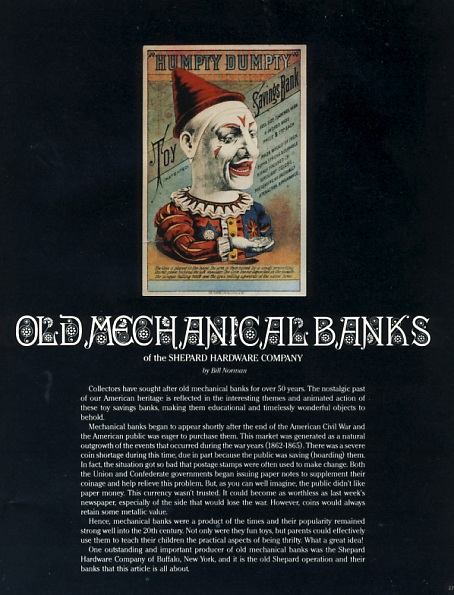
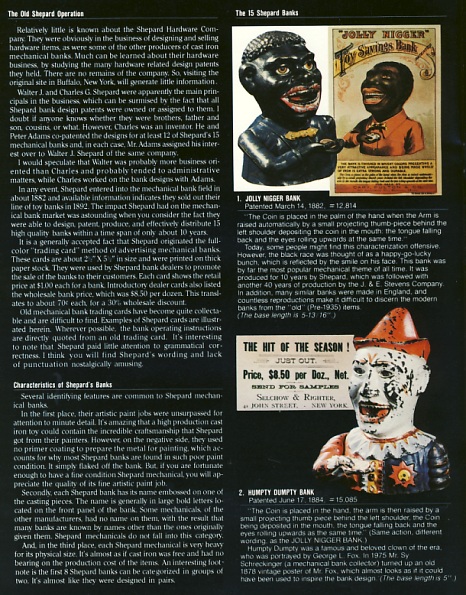
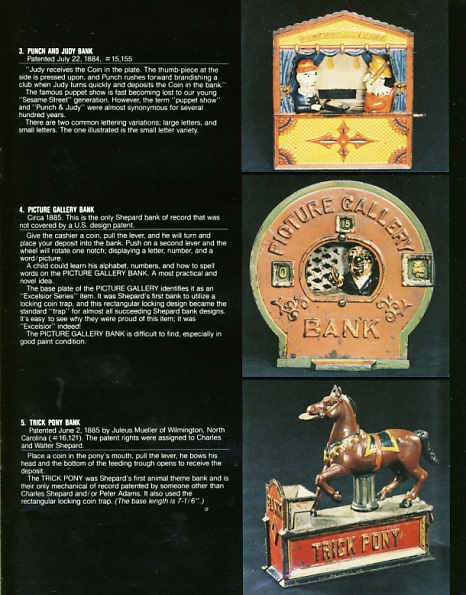
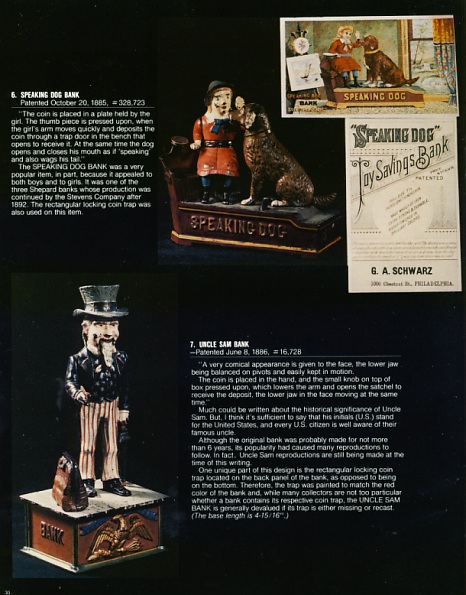

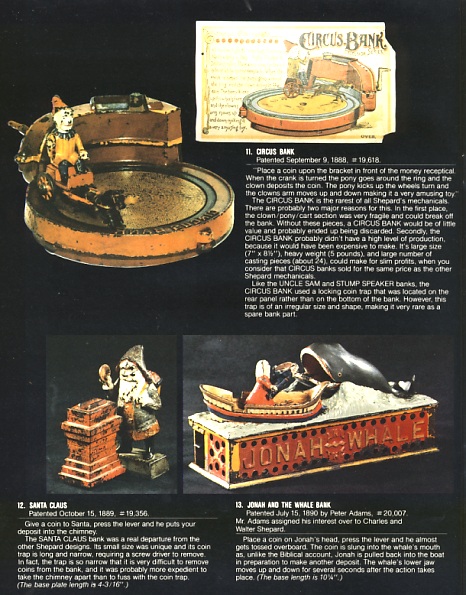
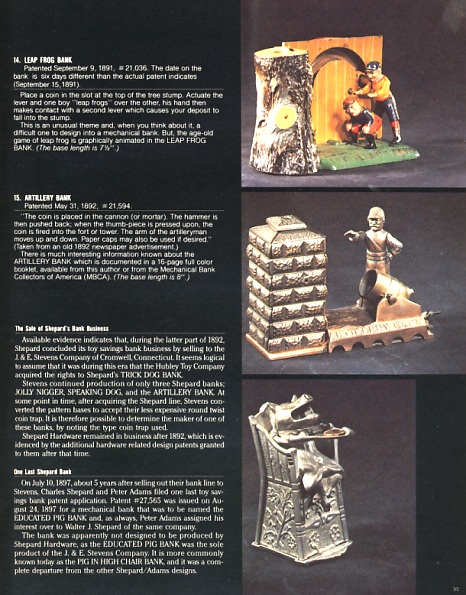
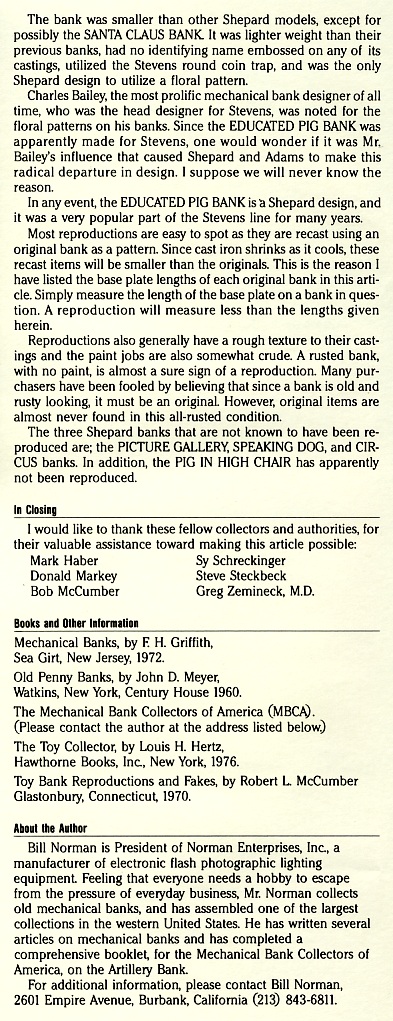
|
|









